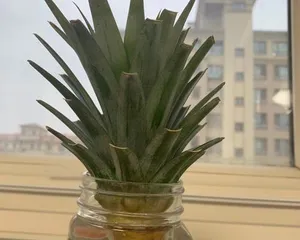Pineapple is a nutrient-rich tropical fruit, rich in beneficial nutrients for the human body such as vitamin C, B vitamins, and minerals, and is therefore very popular. Many people probably want to grow some pineapples at home, but don't know if they can be planted in the soil. Let's find out more in detail.

Choose the right variety
Choose varieties that are suitable for the local climate and soil conditions, such as white pineapple, golden pineapple, and glutinous pineapple. These varieties have strong adaptability, are relatively drought-tolerant and cold-tolerant, and are suitable for planting in the soil.
Choose the right soil
Select well-drained and fertile soil, and improve soil quality by adding well-rotted organic fertilizer. The soil pH value should be between 5.5-7.0, as being too acidic or too alkaline will affect the growth and development of the pineapple.

Prepare the planting hole
Dig a planting hole with a depth of 40-50 cm and a width of 60-80 cm. Spread well-draining sand and gravel at the bottom of the hole, then pour in a mixture of base fertilizer and well-rotted organic fertilizer.
Select appropriate seedlings
Select seedlings that are vigorous, have green leaves, and well-developed roots. It is best to use one-year-old or two-year-old pineapple seedlings, which can be taken directly from the crown or the stalk.
Pre-transplant treatment
Appropriate treatment is required before transplanting. Remove old and diseased leaves, and at the same time, prune the roots to make them more conducive to growth and development. After treatment, water the planting hole thoroughly.

Watering properly
Pineapples have a high demand for water, but they should not be overwatered. Water reasonably according to the weather conditions and soil moisture to keep the soil moist while avoiding waterlogging.
Fertilizing
Apply compound fertilizer once a month to increase the nutrient supply for the pineapple. The fertilizer should be evenly spread around the pineapple, not on its leaves, to avoid burning.
Pest and disease control
Pineapples are susceptible to pests and diseases, such as aphids, red spiders, and powdery mildew. Biological control, chemical control, and other methods can be used to control pests and diseases.
Pay attention to suitable temperature
The suitable temperature for pineapple growth is 20-35°C. When the temperature is below 10°C or above 40°C, the growth and development of the pineapple will be affected.
Pay attention to shading
In high summer temperatures, you can install a white sunshade net around the pineapple or use other shading measures to prevent direct sunlight from scorching the pineapple.
Regular weeding
Regularly remove weeds around the planting hole to keep the soil loose and well-ventilated.
Pay attention to moisture retention
Methods such as mulching and creating a microclimate can be used to retain moisture and keep the soil moist.
Timely pruning
During the growth process of the pineapple, appropriate pruning is necessary to remove unhealthy or damaged parts to promote plant growth and fruit development.
Harvesting the fruit
Wait until the pineapple is fully ripe, with the peel turning yellow and the flesh becoming soft and tender, before harvesting. Wear gloves when harvesting to avoid pricking your fingers.
In summary, pineapples can be planted in the soil, but attention must be paid to choosing suitable varieties, soil, and appropriate temperature, watering, fertilization, etc. Through proper care, you can get sweet and delicious pineapple fruits.